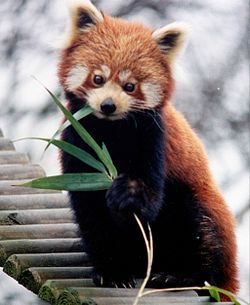Red panda
The red panda (Ailurus fulgens) is a mammal. It is the only species of the Ailuridae family. There are two subspecies: Ailurus fulgens fulgens and Ailurus fulgens styani. It is also known as lesser panda, cat-bear, bear-cat and firefox.
| Red panda | |
|---|---|

| |
| Conservation status | |
| Scientific classification | |
| Kingdom: | |
| Class: | |
| Order: | |
| Suborder: | |
| Superfamily: | |
| Family: | Ailuridae
|
| Genus: | Ailurus
|
| Binomial name | |
| Ailurus fulgens | |
Overview
Most that are bred at Japanese zoos are Ailurus fulgens styani. They are called レッサーパンダ (ressaa panda) in Japanese and 小熊貓 (xiǎo xìong māo) in Chinese, literally translating to English as "small bear-cat", or "fox-bear." [1] The IUCN classes them as endangered.
The red panda is not closely related to the giant panda: they are in different families, but share a diet of mostly bamboo. They have both adapted to eating plant material, which is unusual for members of the Carnivora.
French zoologist Frédéric Cuvier first described the western red panda Ailurus fulgens in 1825, 48 years before the giant panda was classified.[2]
A scientist by the name Brian Houghton Hodgson, was one of the first people to look more deeply into the red panda because up until he did, there was not much known about the species.
Habitat
The red panda lives in the southern part of China, Sikkim, Nepal, and the Himalaya mountains in high trees. In the Indian kingdom of Sikkim it is the state animal. As an endangered species it is protected by laws in the countries where it lives. Two nearly complete skeletons have been found at the Gray Fossil Site in Gray, Tennessee. [3]
Appearance and life
Red pandas are about 50-60 centimeters long and weigh between three and five kilograms. They have chestnut colored hair, and their faces have white markings. A red panda's tail can measure from 30 to 50 centimeters long (Almost the length of their body) which provides them with balance while navigating the treetops. They will also use these tails as wraparound blankets in their chilly mountain habitat.[4] They live alone while they are adults. They have thumb-like appendages for grabbing Bamboo, similar to giant pandas. Red pandas feed mainly on bamboo using their opposable thumb. While their thumb-like appendages can be used in the same way as that of giant pandas, it is believed that the red panda’s opposable thumbs may have evolved as an adaptation for grasping branches in trees rather than for stripping bamboo.[5] The red panda can be found spending most of their day on top of tree branches. Their thumb-like appendages make them skilled climbers. [6]They live eight to ten years in the wild and up to 15 years in captivity.[7] They have the digestive system and skeleton of a carnivore, but they mostly eat plants.[8] In addition to Bamboo, the Red Panda also eats fruits, tuberous roots, acorns, small mammals, bugs, grubs, birds, grasses, and beech mast.[9] The Red Panda is classified as crepuscular, which means they are active around dawn and sunset, sleeping during the night and midday instead. Hodgson observed that they are monogamous and only breed once a year.
Red Panda Media
Watercolour painting of a red panda commissioned by Thomas Hardwicke c. 1820
Sounds of red panda twittering
Red panda at Symbio Wildlife Park
References
| Wikimedia Commons has media related to Lua error in Module:Commons_link at line 62: attempt to index field 'wikibase' (a nil value).. |
Glatston, A. R. (2011). Red panda biology and conservation of the first panda (1st ed.). Academic Press.
- ↑ "Red pandas, facts and photos". National Geographic.
- ↑ "Red Panda | San Diego Zoo Animals & Plants". animals.sandiegozoo.org. Retrieved 2023-08-31.
- ↑ "Fossil of red panda found". NBC News. 2006-09-22. Retrieved 2024-05-06.
- ↑ "15 Fantastic Facts About Red Pandas". redpandanetwork.org. Retrieved 2023-08-31.
- ↑ "Top 5 facts about Red Pandas". WWF. Retrieved 2023-09-05.
- ↑ "Is a Red Panda a Bear? And More Red Panda Facts". Smithsonian's National Zoo. 2020-09-18. Retrieved 2023-09-16.
- ↑ Schmidt, Amanda (2023-03-03). "Red Panda Fact Sheet | Blog | Nature | PBS". Nature. Retrieved 2023-08-31.
- ↑ "Is a Red Panda a Bear? And More Red Panda Facts". Smithsonian's National Zoo. 2020-09-18. Retrieved 2023-09-05.
- ↑ "Red panda". Smithsonian's National Zoo and Conservation Biology Institute. Retrieved 2024-05-06.
| Wikispecies has information on: Ailurus fulgens. |







